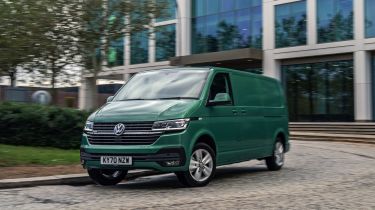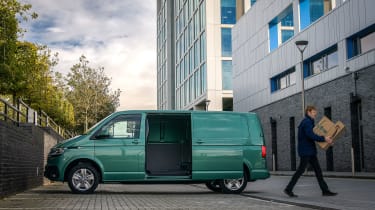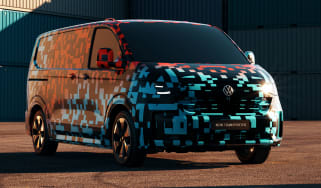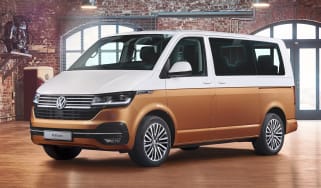Volkswagen eTransporter (2020-2021) review
The now-discontinued Volkswagen Abt eTransporter fell short of other medium-sized electric vans on the market, which offer a longer range for less money

Pros
- Classy interior
- Quiet on the move
- Kombi crew-cab version
Cons
- More expensive than most rivals
- Just one van body available
- Electric range quite short
| Van type | Range | Wallbox charge time | Rapid charge time |
|---|---|---|---|
| Electric | 82 miles | 5hrs 30mins (0-100%, 7.2kW) | 45mins (10-80%, 50kW) |
While Volkswagen continues to expand its ID range of electric cars, including the ID.3 hatchback, ID.4 SUV and ID.5 coupe-SUV, the German brand lags behind the competition when it comes to electric commercial vehicles. The eTransporter was VW's first fully electric van in the UK, facing rivals from Citroen, Fiat, Toyota, and Vauxhall, among others. After only a short time on sale, it was discontinued in early 2022 ahead of the arrival of the ID.Buzz Cargo.
The Abt eTransporter T6.1, to give it its full official name isn't a fully fledged VW product: it was developed by independent contractor Abt – a company historically associated with souped-up Audis and Volkswagens, but one that's turning its hand to electric drivetrain technology off the back of its involvement in Formula E racing.
The running gear fitted by Abt to make an eTransporter is made up of a 108bhp electric motor driving the front wheels and a 37.3kWh battery storing energy. It's essentially the same technology that was fitted to the now-discontinued e-Golf hatchback, which means it's no longer at the cutting edge; the e-Transporter's range and performance figures are a bit underwhelming as a result.
Its claimed driving range is just 82 miles (compared to 93 for the Mercedes eVito and 143 for the Vauxhall Vivaro-e and its Citroen, Peugeot and Toyota sister models), while top speed is limited to 56mph in order to conserve range. Rapid charging from a 50kW public point will take about 45 minutes to 80% capacity, while a full charge from a 7.2kW wallbox will be completed in around five and a half hours.
As is common with most fully electric vans, mounting the battery pack low down in the floor means there has been no encroachment on the eTransporter's load area, which has the same 6.7 cubic-metre volume as the diesel van. Maximum payload is a bit down on the diesel, however, at less than a tonne; this reflects the fact that electric vans like the eTransporter are aimed at delivery firms concerned more with volume than weight.
Alternatively, should you need to carry more passengers than cargo, a 'Kombi' crew-cab version (seating either five or six in total) is available. The panel van has a steel bulkhead behind the cab, and as standard there's a single sliding side door and twin doors at the back (a top-hinged rear tailgate is a no-cost option and a second sliding side door can be added at extra cost). The Kombi also has a single sliding side door (with a window), while there's a second pane of glass on the opposite side. At the back, the Kombi has a tailgate with a wiper.
One area where the eTransporter comes up slightly short is payload weights. None of the electric models can carry more than a tonne in payload, while all versions of the 3.2-tonne diesel Transporter can carry more than a tonne. However, electric vans are often designed to cater for last-mile delivery services, where cargo volume takes priority over maximum weight.
The eTransporter is no different to its rivals when it comes to being exempt from road tax and the London Congestion Charge, cheap to charge and less expensive to service than a combustion-engined van. At the time of writing, Volkswagen was charging £399 for the first three services, first MoT, pollen filter and brake fluid replacement. Service is needed once a year or every 25,000 miles (whichever comes first), with an extended inspection due at three years/75,000 miles.
To drive, the eTransporter feels quite similar to its diesel equivalent, but it's obviously much quieter on the move; tyre roar is pretty much all you hear, and even that's only evident at higher speeds. Although the VW is as quick off the line as any other electric van, it soon seems to run out of puff, as you're limited to just three-quarters of its total 108bhp output unless you press the accelerator harder, forcing it to 'kick down' into full-power mode.
Ride and handling are decent, and with the heavy batteries placed low down in the chassis, the e-Transporter is less prone to bouncing and crashing around when empty than its combustion-engined counterpart. Inside, the cabin is largely the same as that of the regular Transporter, which is good news, as you get much the same high-quality materials and fittings used in Volkswagen passenger cars. The dash top, door bins and centre console all have cup-holders, so there's space for everyone's Starbucks order, while USB ports and 12v sockets allow phones, laptops or other equipment to be charged and used. A 6.5-inch infotainment touchscreen is standard, and an even larger unit with sat nav can be fitted as an option.
Overall, the eTransporter is a decent enough electric van package on its own terms, but there's no getting away from the fact there are more up-to-date rivals out there that can go further on a charge, and cost less to buy in the first place. Volkswagen may yet regret taking its eye off the ball in what could become a crucial electric-vehicle market in the years to come.







